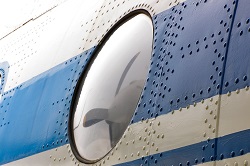Self-healing polymers for aircraft composites
Self-healing materials need minimal maintenance and have the ability to repair their own micro-cracks and breaks. They have become a holy grail for the aerospace industry. HIPOCRATES has made their use a step closer following its mission to design epoxy-based self-healing composites. They based these new self-healing materials on already widely used resins, so that they could be simply incorporated into current aerospace production methods. Laminated polymer composite materials are used in aircraft parts such as engine propellers, the fuselage and interior components and micro-cracks. But micro-cracks are a big problem, reducing the strength of the materials. Up to now, repairs needed manual intervention, but the development of self-healing polymeric materials over the last decade could change this. Self-healing mechanisms have already been explored for concrete, asphalt, hydrogels and biomedical polymers. ‘The strategy provides a promising path to extend the life of polymeric components,’ says HIPOCRATES co-ordinator, Dr Sonia Flórez of TECNALIA in San Sebastián, Spain. Designing structural self-healing polymer composite materials for the aerospace industry has been a challenge says Flórez - ‘there are several practical limitations that needed to be overcome.’ These included the rate of healing, the stability of the process as well as materials and production costs. ‘A critical step is the compatibility of such technologies into current processing and manufacturing methods,’ she adds. To do this, HIPOCRATES has translated known self-healing chemistries into epoxy resin systems already commonly used in aerospace composites and developed methods to incorporate self-healing technologies into existing processing techniques. The HIPOCRATES-project has investigated two different self-healing strategies. One involves encapsulating micro-cracks. Flórez explains, ‘Microcapsules containing self-healing agents are added to the composites polymer mix, in which a catalyst that starts the reaction has already been dispersed. When a micro-crack occurs, the capsules break and release the healing agent, which comes into contact with the catalyst. The resulting polymerisation reaction closes the crack and prevents further crack growth’. HIPOCRATES has been able to take this strategy one step further in developing an ‘all in one microcapsule’ self-healing system which is entirely self-contained. Rather than the catalyst being dispersed through the resin matrix, it is encased in the shell of the capsules in a higher concentration, so the healing reaction can occur more efficiently. The second method has been to use reversible polymers.’These materials contain internal linkages, which will reverse the damage and close a crack upon delivery of an external stimulus such as heat, radiation or electrical induction’ say Flórez. This behaviour can be achieved using various reversible polymers and HIPOCRATES synthesized and tested two that are compatible with epoxy systems and can be made from cost effective commercial raw materials. The materials designed by HIPOCRATES were tested in small-scale demonstrators by mimicking the kinds of high velocity impacts experienced by aircraft due for example to collisions with birds, debris and hail. The effect of compression on the repaired materials was tested to see if they would de-laminate and break apart. Ultrasound analysis of the tested new materials found that impact and compression damage could be mitigated by using self-healing materials. ‘The incorporation of capsules provided some protection against the initial mechanical impact, however after healing both strategies showed higher resistance to compression than before,’ explains Flórez . The new materials showed 5-10 % higher resistance to compression forces making the repaired materials resistant to the sorts of impacts that would cause damage before the repair. The new composites designed in the HIPOCRTES project still need to undergo more testing before they can be used in real applications, but the project team hope that in the next five years these self-healing materials might help reduce aircraft costs by providing an alternative to expensive manual testing and repair.
Keywords
HIPPOCRATES, Self-healing polymers, Composite materials, Epoxy-resins, microcapsules, aeronautical composites

